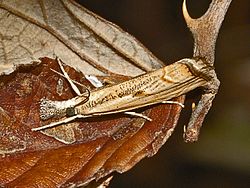| Agriphila geniculea | |
|---|---|
 | |
| Scientific classification | |
| Kingdom: | Animalia |
| Phylum: | Arthropoda |
| Class: | Insecta |
| Order: | Lepidoptera |
| Family: | Crambidae |
| Genus: | Agriphila |
| Species: | A. geniculea |
| Binomial name | |
| Agriphila geniculea (Haworth, 1811) | |
| Synonyms | |
| |
Agriphila geniculea, the elbow-striped grass-veneer, is a species of moth of the family Crambidae. It was first described by Adrian Hardy Haworth in 1811.


